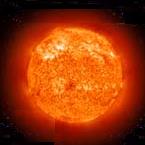 Solar Observations
Solar Observations
-
Daily Observations of Sunspots
Use your Sunspotter® solar telescope to obtain an image of the Sun. If there are any sunspot groups present they should be clearly visible on the white projection screen.
Record your observations by drawing the solar image or taking a digital photo, ideally both. Take care to show the correct size and location of any sunspots. Include the date and time of your observation on your sheet.
This will allow you to create a story board sequence of sunspots over successive days. Use this to try and determine how fast the Sun is rotating.
Design Task: One of the difficulties in recording an image of the Sun is drawing a circle to represent the disc of the Sun. To overcome this and help you take observations quickly and accurately try and design a template that you can print out or photocopy. Your template should include a circle for the correct size of the Sun's image, somewhere to record the time and date and a marker to show which way it was aligned in the Sunspotter®. You may like to include a background of graph paper grid on your template. This will help you measure the position of sunspots more accurately.
Hint: The slim yellow booklet that comes with the Sunspotter® describes eight activities that you can try.
-
Sunrise and Sunset
Keep a journal of the times of sunrise and sunset at your home. Compare this with the time given on the local weather report. Are they the same?
One evening watch where the Sun appears to set from your home. Record this position, for example "The Sun set just to the right of the distant hill". Try and give an indication of distance or scale, for example "... the Sun was one fist width to the left of the peak of the hill when my arm was fully stretched out in front of my face...". You could even try and give a compass bearing.
If you wake up early enough do the same for sunrise.
One observation of sunrise or sunset will not tell you too much. You need to build up a set of observations over the course of the year. Try and take at least one measurement a week from the same location and record it in your journal. You could make a simple sketch of where the Sun rises or sets each time. You could even take a photo with a digital camera.
Once you have several observations over a few weeks or months what trends do you see?
-
Transit of Mercury, Thursday 9 November 2006.
We are currently planning ways to observe this transit of Mercury. A transit is where the planet passes across the face of the Sun as seen from Earth. This upcoming transit occurs early in the morning in Australia. It will be visible in Sydney from 6.12 am local summer time, lasting till 11.10 am. Unfortunately for our partner schools the transit starts before sunrise in Western Australia. It finishes at 8.11 am local time in Perth and Geraldton.
We hope to be able to observe the complete transit from Sydney and Bathurst. The WA schools should be able to see about half the tranit if they get up early! Hopefully each school will be able to view the end of the transit and time when this occurs at their school so that we can compare times later.
Mercury will appear as a very small disc, 1/194th the size of the Sun. Using the Sunspotters it should be about 0.3mm across, small, but still able to be detected.
The CSU Remote Telescope will be webcasting the transit live from Bathurst.
The Astronomical Society of Australia has produced a factsheet about the transit that can be downloaded from their website.
Ian Musgrave of Southern Skywatch has written a very useful web page on the transit for Australian observers.
